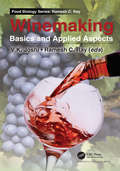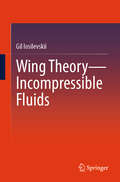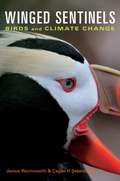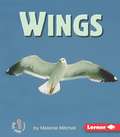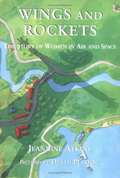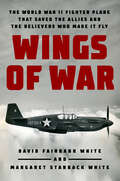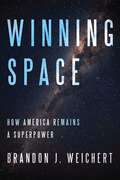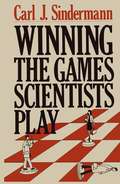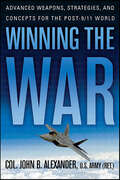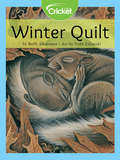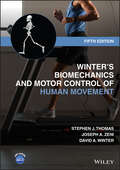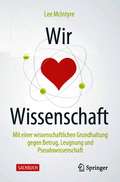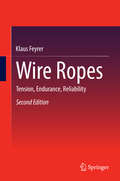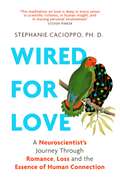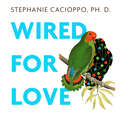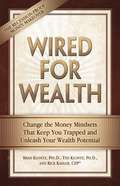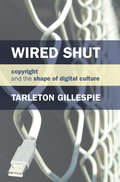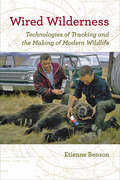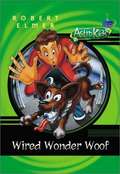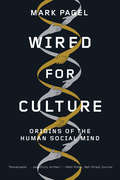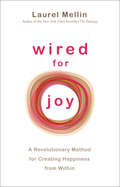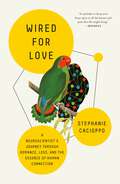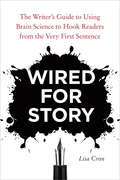- Table View
- List View
Winemaking: Basics and Applied Aspects (Food Biology Series)
by V. K. JoshiWine is one of the oldest forms of alcoholic beverages known to man. Estimates date its origins back to 6000 B.C. Ever since, it has occupied a significant role in our lives, be it for consumption, social virtues, therapeutic value, its flavoring in foods, etc. A study of wine production and the technology of winemaking is thus imperative. The preparation of wine involves steps from harvesting the grapes, fermenting the must, maturing the wine, stabilizing it finally, to getting the bottled wine to consumers. The variety of cultivars, methods of production, and style of wine, along with presentation and consumption pattern add to the complexity of winemaking. In the past couple of decades, there have been major technological advances in wine production in the areas of cultivation of grapes, biochemistry and methods of production of different types of wines, usage of analytical techniques has enabled us to produce higher quality wine. The technological inputs of a table wine, dessert wine or sparkling wine, are different and has significance to the consumer. The role played by the killer yeast, recombinant DNA technology, application of enzyme technology and new analytical methods of wine evaluation, all call for a comprehensive review of the advances made. This comprehensive volume provides a holistic view of the basics and applied aspects of wine production and technology. The book comprises production steps, dotted with the latest trends or the innovations in the fields. It draws upon the expertise of leading researchers in the wine making worldwide.
Wing Theory—Incompressible Fluids
by Gil IosilevskiiA high Reynolds number flow about a lifting wing typically forms a thin boundary layer on its surface, which smoothly merges with a thin vortical wake behind it. An asymptotic theory, based on wing’s thickness, camber, angle of attack and aspect ratio, can turn this simple observation into a fair approximation for the pressure loads acting on a finite wing in generally non-uniform motion. This book unfolds this theory step-by-step, revisiting a few well-known and some less-known results along the way. The fidelity of the approximation is demonstrated in numerous examples. The stress in the book is on mathematical rigor, and all non-trivial steps are scrutinized in numerous appendices. The book can be a basis for a graduate course on theoretical aerodynamics, but can also be a reference for quite a few practical aerodynamic models.
Winged Sentinels
by Cagan H. Sekercioglu Janice Wormworth'The ability of the birds to show us the consequences of our own actions is among their most important and least appreciated attributes. Despite the free advice of the birds, we do not pay attention', said Marjory Stoneman Douglas in 1947. From ice-dependent penguins of Antarctica to songbirds that migrate across the Sahara, birds' responses provide early warning signs of the impact of climate change. Winged Sentinels: Birds and Climate Change uses colourful examples to show how particular groups of birds face heightened threats from climate change and to explore how we can help birds adapt in a warming world. Generously illustrated with colour photographs, the book is a fascinating insight into what climate change means for birds, and the potential consequences of ignoring these warning signs.
Wings (Fountas & Pinnell LLI Blue #Level B)
by Melanie MitchellProvides a simple introduction to the different types of wings, including the wings of a bird, bee, bat, and owl.
Wings and Rockets: The Story of Women in Air and Space
by Jeannine AtkinsCelebrating the hundredth anniversary of powered flight From Katharine Wright, sister of the Wright brothers, to Eileen Collins, the first woman commander of a spacecraft, scores of women have played critical roles in our country's history of aviation. Wilbur and Orville Wright, who pioneered powered flight in 1903, knew how much they owed to Katharine. "When the world speaks of the Wrights," said Orville, "they should not forget our sister. " Although Katharine Wright was among the first women to ride in an airplane, Blanche Stuart Scott was the first to sit at the controls. To achieve her dream, Blanche overcame sexism and other obstacles. The same can be said of every woman whose piloting career is highlighted here - Bessie Coleman, Amelia Earhart, Jackie Cochran, Ann Baumgartner Carl, Jerrie Cobb, Shannon Wells Lucid, and others. Their stories are sure to fire the imaginations of readers and encourage them to "follow their hearts into the sky" - or anywhere at all. This beautifully articulated history of American women who broke barriers to achieve an especially satisfying success is enhanced by clever, captivating halftone illustrations.
Wings of War: The World War II Fighter Plane that Saved the Allies and the Believers Who Made It Fly
by David Fairbank White Margaret Stanback WhiteThe incredible, untold story behind the rise of the P-51 Mustang, the World War II fighter plane that destroyed the Luftwaffe and made D-Day possible&“Aviation buffs will cheer this high-flying saga.&”—Publishers Weekly • &“[A] fascinating book about passion and innovation.&”—Walter Isaacson • &“An essential book for those who appreciate tales of military bravery, and also for all seeking understanding of decision-making under pressure. A major contribution.&”—E. J. Dionne, Jr.When the P-51 Mustang began tearing across European skies in early 1944, the Allies had been losing the air war for years. Staggering numbers of bomber crews, both British and American, had been shot down and killed thanks to the Luftwaffe&’s superior fighter force. Not only did the air war appear grim, but any landing of troops in France was impossible while German fighters hunted overhead. But behind the scenes, a team of visionaries had begun to design a bold new type of airplane, one that could outrun and outmaneuver Germany&’s best. Wings of War is the incredible true story of the P-51 Mustang fighter and the unlikely crew of designers, engineers, test pilots, and army officers who brought it from the drafting table to the skies over World War II. This is hardly a straightforward tale of building an airplane—for years, the team was stymied by corruption within the defense industry and stonewalled by the Army Air Forces, who failed to understand the Mustang&’s potential. But when squadrons of Mustangs were finally unleashed over Hitler&’s empire, the Luftwaffe was decimated within months, clearing the skies for D-Day. A compelling, character-focused narrative replete with innovation, determination, and bravery, Wings of War is the never-before-told story of the airplane that truly changed the course of World War II.
Winning Space: How America Remains a Superpower
by Brandon J. WeichertWhen President Donald J. Trump announced the creation of America&’s sixth branch of the military, the United States Space Force, many in Washington scoffed. But, U.S. rivals in China, Russia, Iran, and North Korea took notice.Since the end of the Cold War, these American foes have chafed under the full-spectrum dominance that the American superpower has enjoyed globally. They have identified space as a key strategic domain where they can challenge—and possibly defeat—the United States military. And, depriving the U.S. military and/or its economy of access to space during an international crisis could spell doom for the United States in other strategic domains (land, sea, air, and cyberspace). After all, space is critical for America&’s vaunted information dominance. Satellites overhead are the backbone of America&’s global military. Remove them from orbit and U.S. forces worldwide are rendered deaf, dumb, and blind. What&’s more, space is a more than $1 trillion economy just waiting to be developed. Whichever country gets there first will have considerable economic and geopolitical power on Earth. Despite President Trump&’s creation of the Space Force, Swamp Dwellers in Washington continue resisting his reforms to U.S. space and technology policy. Winning Space tracks the increasing competition the United States is facing in the technology sector and depicts how the United States has been engaged in a Second Space Race—and how it has been losing. Author Brandon Weichert warns how the United States is at risk for a Pearl Harbor-type event in space. Weichert advocates for the full embrace of Trump&’s reforms for America's flailing space policy, while also calling for a minimum $1 trillion investment in advanced research and development here in the United States, to stay ahead of America&’s advancing foes. Contrary to what many Americans may think, the United States has been declining in space and the high-technology development sector. Should it lose its dominance in these areas, it will surely lose its superpower status. The next decade presents U.S. policymakers one last chance to preserve the superpower status that America fought two world wars and the Cold War to build. Time is not on our side. We are on notice, but we have not noticed.
Winning the Games Scientists Play
by Carl J. SindermannIn this inspiring book of personal insight and sound advice, veteran scientist Carl J. Sindermann gives an insider's look at the competitive world of science and reveals the best strategies for attaining prominence and success.
Winning the War: Advanced Weapons, Strategies, and Concepts for the Post-9/11 World
by John B. AlexanderTwenty-second century historians will note that a new World War began on 9/11/2001. In reality, it began much earlier. Competing value systems and the lust for natural resources will precipitate an inevitable clash of civilizations. Currently, we face elusive foes-foes who play by other rules-and in fact, we are already engaged in brutal, truly asymmetric conflict with varied forms of fighting; terrorism is but an isolated part. The increasing number of polymorphic hostilities requires revolutionary and unconventional responses. Special operations are the norm. Nanoscale, biological, and digital technologies have transformed how we fight future wars. Tactical lasers that zap pinpoint targets at twenty kilometers are being developed, as is the millimeter-wave Active Denial System that causes intense pain to those exposed. The "Mother of all Bombs" has been dropped, as have thermobaric weapons that destroy caves and bunkers. Robots roam the battlefield while exotic sensors catalogue nearly every facet of our lives. Paralyzing electrical shock weapons are in the hands of police. Even phasers on stun are closer than you think. Winning the War details the technologies and concepts necessary to ultimately determine the outcome of this global conflict. Via realistic scenarios from recovering tourists kidnapped by terrorists, to bringing down drug cartels in the Amazon, and even preventing Armageddon in the Middle East, Winning the War provides an insider's view into how these futuristic weapons will be used and into the complexities of modern warfare. Bold and controversial measures are prescribed, including the essential nature of absolute domination of space. Winning the War makes clear that drastic and innovative actions will be necessary to ensure our national survival.
Winter Quilt
by Buffy SilvermanFind out what squirrels are up to when they remove brown oak leaves from tree branches.
Winter's Biomechanics and Motor Control of Human Movement
by David A. Winter Stephen J. Thomas Joseph A. ZeniAn In-Depth Resource for Understanding the Foundational Concepts and Clinical Applications in the Field of Biomechanics Winter’s Biomechanics and Motor Control of Human Movement is highly suitable as a textbook for today’s biomechanics students who may come from many diverse academic programs and professional sectors. The work covers foundational theoretical and mathematical concepts in biomechanics, as well as up-to-date data collection, interpretation, and storage techniques. It also highlights the contemporary clinical applications of biomechanical research. New case studies related to cerebral palsy, patellar femoral pain syndrome, knee osteoarthritis, and ulnar collateral ligament reconstruction are also included. The work appeals to a broad audience within the field of biomechanics, an interdisciplinary field with applications in mechanical engineering, medicine, physical therapy, sports and exercise, and product development. Authors at leading universities guide the reader through the latest advancements in the field while also imparting critical foundational knowledge to allow for subject matter mastery and more precise practical application. Concepts covered in the book include: Biomechanical signal processing, anthropometry, kinematics and kinetics, muscle mechanics, and kinesiological electromyography Forward simulations and muscle-actuated simulations, static and dynamic balance, and the role of the central nervous system in biomechanics Movement sequencing and the kinetic chain concept, electromagnetic systems, inertial sensors, clinical measures of kinematics, and the advantages and disadvantages of different types of force plates Markerset design and event detection for gait and athletic motions like jumping, landing, and pitching Guidance on setting up a motion lab and access to online Excel spreadsheets with kinematic and kinetic marker data By providing a combination of theoretical and practical knowledge, Winter’s Biomechanics and Motor Control of Human Movement will appeal to biomedical engineers working in the field of biomechanics and allied professionals in the medical, rehabilitation, and sports industries. Its comprehensive overall insight into the field of biomechanics also makes the work a highly useful resource for students and teachers of biomechanics at all levels of experience and expertise.
Wir drehen am Klima - na und? (Erlebnis Wissenschaft)
by Gerd GanteförDem Klimawandel aktiv begegnen - das neue Buch vom Erfolgsautor Gerd Ganteför Der Klimawandel ist nicht aufzuhalten - in weiten Teilen der Bevölkerung und der Fachwelt ist diese Aussage unbestritten. Aber was sind die genauen Ursachen? <P><P>Vor allem, was kann man dagegen tun? Die Lösung scheint so einfach und liegt vermeintlich auf der Hand: Die Energiewende muss kommen, Wind- und Sonnenenergie endlich maximal genutzt werden. Doch ist das im Weltmaßstab überhaupt möglich? Im Angesicht der heutigen globalen Probleme, Ressourcenverknappung, Armut und Bevölkerungswachstum schwanken unsere Zukunftsvisionen zwischen absoluten Horrorszenarien und utopischen Träumereien. Auf der einen Seite scheinen wir in dem Teufelskreislauf gefangen, der uns momentan zwingt, auf die fossilen Rohstoffe Erdöl, Erdgas und Kohle zurückzugreifen, was die Klimakatastrophe mit gewaltigeren Stürmen, vermehrten Dürren und Überschwemmungen noch beschleunigen und verschlimmern würde. Dem gegenüber stehen die Möglichkeiten einer (vermeintlich) ökologischen Lebensweise, die auf Energie weitgehend verzichtet, oder die Entwicklung zu einer hochtechnisierten Welt mit noch höherem Energiekonsum.
Wir lieben Wissenschaft: Mit einer wissenschaftlichen Grundhaltung gegen Betrug, Leugnung und Pseudowissenschaft
by Lee MclntyreAngriffe auf die Wissenschaft sind alltäglich geworden: Die Erforschung des Klimawandels sei keine „anständige“ Wissenschaft, die Evolution „nur eine Theorie“, die „Wahrheit“ über Impfstoffe werde vertuscht. In diesem Buch diskutiert Lee McIntyre, was Wissenschaft von Nicht-Wissenschaft unterscheidet: der Stellenwert der Evidenz und die Bereitschaft, Theorien auf Basis neuer Evidenz zu verwerfen. Diese beiden wesentlichen Eigenschaften nennt er die „wissenschaftliche Grundhaltung“. McIntyre führt Beispiele an, die sowohl den wissenschaftlichen Erfolg (eine Verringerung des Kindbettfiebers im 19. Jahrhundert) als auch das Scheitern (die fehlerhafte „Entdeckung“ der kalten Fusion im 20. Jahrhundert) veranschaulichen. Er beschreibt den Wandel der Medizin von einer weitgehend auf Vermutungen beruhenden Praxis zu einer Wissenschaft, die sich auf Beweise stützt; er betrachtet wissenschaftlichen Betrug und untersucht die Positionen von ideologiegetriebenen Leugnern, Pseudowissenschaftlern und „Skeptikern“, die wissenschaftliche Erkenntnisse ablehnen.Das Buch macht in einer Welt der „alternativen Fakten“ klar, dass die Beachtung von Fakten ein einzigartig wirkungsvolles Instrument zur Verteidigung der Wissenschaft selbst ist.
Wire Ropes
by Klaus FeyrerThe main goal of this book is to present the methods used to calculate the most important parameters for ropes, and to explain how they are applied on the basis of numerous sample calculations. The book, based on the most important chapters of the German book DRAHTSEILE, has been updated to reflect the latest developments, with the new edition especially focusing on computational methods for wire ropes. Many new calculations and examples have also been added to facilitate the dimensioning and calculation of mechanical characteristics of wire ropes. This book offers a valuable resource for all those working with wire ropes, including construction engineers, operators and supervisors of machines and installations involving wire ropes.
Wired For Love: A Neuroscientist’s Journey Through Romance, Loss and the Essence of Human Connection
by Stephanie CacioppoFrom the world's foremost neuroscientist of romantic love comes a personal story of connection and heartbreak that brings new understanding to an old truth: it is better to have loved and lost than never to have loved at all.At thirty-seven, Dr. Stephanie Cacioppo was content to be single. She was fulfilled by her work on the neuroscience of romantic love; how finding and growing with a partner literally reshapes our brains. That was, until she met the foremost neuroscientist of loneliness. A whirlwind romance led to marriage, to sharing an office at the University of Chicago. After seven years of being inseparable at work and home, she lost her beloved husband following a devastating battle with cancer.In Wired for Love, Dr. Stephanie Cacioppo tells not just a science story, but also a love story. She shares revelatory insights into how we fall in love, and why; what makes love last; and how we process love lost - all grounded in cutting-edge findings in brain chemistry and behavioural science. Woven through it all is her moving personal story, from astonishment, to unbreakable bond, to grief and healing. Her experience and her work enrich each other, creating a singular blend of science and lyricism that's essential reading for anyone looking for connection.
Wired For Love: A Neuroscientist’s Journey Through Romance, Loss and the Essence of Human Connection (Language Acts and Worldmaking #5)
by Stephanie CacioppoFrom the world's foremost neuroscientist of romantic love comes the untold story of what happens in our brains when we are in love.Dr Stephanie Cacioppo shares revelatory insights into how we fall in love, and why; what makes love last; and how we process love lost - all grounded in cutting-edge findings in brain chemistry and behavioural science. You will learn how to make a closer bond in your relationship, how to make sure the spark isn't lost, how to tell the difference between lust and love, and how to find a path beyond heartbreak or bereavement.Wired for Love is not just a science story, but also a love story. At thirty-seven, Dr. Stephanie Cacioppo was content to be single. She was fulfilled by her work on the neuroscience of romantic love; how finding and growing with a partner literally reshapes our brains. That was, until she met the foremost neuroscientist of loneliness. A whirlwind romance led to marriage, to sharing an office at the University of Chicago. After seven years of being inseparable at work and home, she lost her beloved husband following a devastating battle with cancer.This moving personal story is woven through the book, from astonishment, to unbreakable bond, to grief and healing. Her experience and her work enrich each other, creating a singular blend of science, lyricism and expert tips that are essential reading for anyone looking for connection.
Wired For Wealth: Change The Money Mindsets That Keep You Trapped and Unleash Your Wealth Potential
by Brad Klontz Ted Klontz Rick KahlerRecession-Proof Your Mind and Rewire Your Brain for Wealth As financial stress mounts and an economic crash looms, Wired for Wealth shows you that the biggest threat to your financial health is not a recession; it's your brain. Markets go up and markets go down, but one fact holds true: Your money scripts--the unconscious core beliefs you hold about money--will determine whether you win or lose in the long run. But there is hope. Drawing on the results of a landmark survey of people's money habits, as well as their decades of work improving their clients' financial lives, renowned financial psychologists Drs. Brad Klontz and Ted Klontz and financial planner Rick Kahler, CFP® show you how you can rewire your brain for wealth. Their unexpected insights show you how you can free yourself from excessive debt, financial stress, money avoidance, and a lack of savings. You'll discover: The top 10 money scripts that mess up people's financial lives--and how to change them How to identify your 'financial comfort zone'--and how to break through it How to curtail family money issues, including financial infidelity, financially dependent children, and conflicts over money. What to do if your money scripts are keeping you poor by overspending, underspending, excessive debt, lack of savings, and lack of retirement planning. What to do if your money scripts keeping you poor in spirit--how to release guilt and fear for good, and be at peace with what you have. Entertaining and enlightening, Wired for Wealth will put you in control of your finances and enable you to break through to new levels of wealth and security.
Wired Shut: Copyright and the Shape of Digital Culture (The\mit Press Ser.)
by Tarleton GillespieHow the shift toward "technical copy protection" in the battle over digital copyright depends on changing political and commercial alignments that are profoundly shaping the future of cultural expression in a digital age.While the public and the media have been distracted by the story of Napster, warnings about the evils of "piracy," and lawsuits by the recording and film industries, the enforcement of copyright law in the digital world has quietly shifted from regulating copying to regulating the design of technology. Lawmakers and commercial interests are pursuing what might be called a technical fix: instead of specifying what can and cannot be done legally with a copyrighted work, this new approach calls for the strategic use of encryption technologies to build standards of copyright directly into digital devices so that some uses are possible and others rendered impossible. In Wired Shut, Tarleton Gillespie examines this shift to "technical copy protection" and its profound political, economic, and cultural implications.Gillespie reveals that the real story is not the technological controls themselves but the political, economic, and cultural arrangements being put in place to make them work. He shows that this approach to digital copyright depends on new kinds of alliances among content and technology industries, legislators, regulators, and the courts, and is changing the relationship between law and technology in the process. The film and music industries, he claims, are deploying copyright in order to funnel digital culture into increasingly commercial patterns that threaten to undermine the democratic potential of a network society. In this broad context, Gillespie examines three recent controversies over digital copyright: the failed effort to develop copy protection for portable music players with the Strategic Digital Music Initiative (SDMI); the encryption system used in DVDs, and the film industry's legal response to the tools that challenged them; and the attempt by the FCC to mandate the "broadcast flag" copy protection system for digital television. In each, he argues that whether or not such technical constraints ever succeed, the political alignments required will profoundly shape the future of cultural expression in a digital age.
Wired Wilderness: Technologies of Tracking and the Making of Modern Wildlife (Animals, History, Culture)
by Etienne BensonAmerican wildlife biologists first began fitting animals with radio transmitters in the 1950s. By the 1980s the practice had proven so useful to scientists and nonscientists alike that it became global. Wired Wilderness is the first book-length study of the origin, evolution, use, and impact of these now-commonplace tracking technologies.Combining approaches from environmental history, the history of science and technology, animal studies, and the cultural and political history of the United States, Etienne Benson traces the radio tracking of wild animals across a wide range of institutions, regions, and species and in a variety of contexts. He explains how hunters, animal-rights activists, and other conservation-minded groups gradually turned tagging from a tool for control into a conduit for connection with wildlife. Drawing on extensive archival research, interviews with wildlife biologists and engineers, and in-depth case studies of specific conservation issues—such as the management of deer, grouse, and other game animals in the upper Midwest and the conservation of tigers and rhinoceroses in Nepal—Benson illuminates telemetry's context-dependent uses and meanings as well as commonalities among tagging practices.Wired Wilderness traces the evolution of the modern wildlife biologist’s field practices and shows how the intense interest of nonscientists at once constrained and benefited the field. Scholars of and researchers involved in wildlife management will find this history both fascinating and revealing.
Wired Wonder Woof (AstroKids #3)
by Robert ElmerWELCOME TO 2175! Meet the Astrokids --Mir, Buzz, Miko, DeeBee, and Tag --five friends learning biblical truth through out-of-this-world adventures aboard space station CLEO-7. "Nyet, my jokes aren't always a hit. Still, who knew they'd land me in so much trouble? Especially when I was trying to be serious!" "Please understand, I felt guilty about spying on my friends. It all started with a Galaxian trader--and our dog, Zero-G. Sure, Zero-G can talk, thanks to the Mind-2-Voice collar DeeBee made him. But why was the Galaxian so interested in our space mutt? This guy had to be hiding something. But would the other AstroKids believe me?"
Wired for Culture: Origins of the Human Social Mind
by Mark Pagel"Does an excellent job of using evolutionary biology to discuss the origins of religion, music, art, and . . . morality."--Publishers Weekly, starred review A unique trait of the human species is that our personalities, lifestyles, and worldviews are shaped by an accident of birth--namely, the culture into which we are born. It is our cultures and not our genes that determine which foods we eat, which languages we speak, which people we love and marry, and which people we kill in war. But how did our species develop a mind that is hardwired for culture--and why? Evolutionary biologist Mark Pagel tracks this intriguing question through the last 80,000 years of human evolution, revealing how an innate propensity to contribute and conform to the culture of our birth not only enabled human survival and progress in the past but also continues to influence our behavior today. Shedding light on our species' defining attributes--from art, morality, and altruism to self-interest, deception, and prejudice--Wired for Culture offers surprising new insights into what it means to be human.
Wired for Joy!: A Revolutionary Method For Creating Happiness From Within
by Laurel MellinCan you imagine a world where drug companies throw bake sales to make ends meet? A world without all the jaw clenching, nail biting, and stress-induced melt downs? Eighty percent of health problems today are due to the downstream effects of stress, so learning to break free from stress could dramatically improve your mood, your relationships, your health––and your life. In Wired for Joy , researcher and New York Times -bestselling author Laurel Mellin presents a simple yet proven way to train your brain to move through stress and back to joy. Her method has been called the missing link in health care, as it focuses on rewiring the emotional brain—the caldron of our stress—rather than the thinking brain, which has been the focus of most other stress-busting methods. Based on the cutting-edge science of neuroplasticity, Mellin outlines the five states of the emotional brain. For each state she presents a specific tool that easily and quickly switches the brain back to a state of well-being. Once you know how to make that switch, life becomes easier, and stress symptoms—depression, anxiety, overeating, high blood pressure—tend to fade. Finally, instead of focusing on the symptoms of stress, we can change the wiring that triggers it and experience new sense of freedom in our lives.
Wired for Love: A Neuroscientist's Journey Through Romance, Loss, and the Essence of Human Connection
by Stephanie CacioppoFrom the world’s foremost neuroscientist of romantic love comes a personal story of connection and heartbreak that brings new understanding to an old truth: better to have loved and lost than never to have loved at all.At thirty-seven, Dr. Stephanie Cacioppo was content to be single. She was fulfilled by her work on the neuroscience of romantic love—how finding and growing with a partner literally reshapes our brains. That was, until she met the foremost neuroscientist of loneliness. A whirlwind romance led to marriage and to sharing an office at the University of Chicago. After seven years of being inseparable at work and at home, Stephanie lost her beloved husband, John, following his intense battle with cancer.In Wired for Love, Stephanie tells not just a science story but also a love story. She shares revelatory insights into how and why we fall in love, what makes love last, and how we process love lost—all grounded in cutting-edge findings in brain chemistry and behavioral science. Woven through it all is her moving personal story, from astonishment to unbreakable bond to grief and healing. Her experience and her work enrich each other, creating a singular blend of science and lyricism that’s essential reading for anyone looking for connection.
Wired for Story
by Lisa CronThis guide reveals how writers can utilize cognitive storytelling strategies to craft stories that ignite readers' brains and captivate them through each plot element. Imagine knowing what the brain craves from every tale it encounters, what fuels the success of any great story, and what keeps readers transfixed. Wired for Story reveals these cognitive secrets--and it's a game-changer for anyone who has ever set pen to paper. The vast majority of writing advice focuses on "writing well" as if it were the same as telling a great story. This is exactly where many aspiring writers fail--they strive for beautiful metaphors, authentic dialogue, and interesting characters, losing sight of the one thing that every engaging story must do: ignite the brain's hardwired desire to learn what happens next. When writers tap into the evolutionary purpose of story and electrify our curiosity, it triggers a delicious dopamine rush that tells us to pay attention. Without it, even the most perfect prose won't hold anyone's interest. Backed by recent breakthroughs in neuroscience as well as examples from novels, screenplays, and short stories, Wired for Story offers a revolutionary look at story as the brain experiences it. Each chapter zeroes in on an aspect of the brain, its corresponding revelation about story, and the way to apply it to your storytelling right now.
Wired for Story
by Lisa CronThis guide reveals how writers can utilize cognitive storytelling strategies to craft stories that ignite readers' brains and captivate them through each plot element. Imagine knowing what the brain craves from every tale it encounters, what fuels the success of any great story, and what keeps readers transfixed. Wired for Story reveals these cognitive secrets--and it's a game-changer for anyone who has ever set pen to paper. The vast majority of writing advice focuses on "writing well" as if it were the same as telling a great story. This is exactly where many aspiring writers fail--they strive for beautiful metaphors, authentic dialogue, and interesting characters, losing sight of the one thing that every engaging story must do: ignite the brain's hardwired desire to learn what happens next. When writers tap into the evolutionary purpose of story and electrify our curiosity, it triggers a delicious dopamine rush that tells us to pay attention. Without it, even the most perfect prose won't hold anyone's interest. Backed by recent breakthroughs in neuroscience as well as examples from novels, screenplays, and short stories, Wired for Story offers a revolutionary look at story as the brain experiences it. Each chapter zeroes in on an aspect of the brain, its corresponding revelation about story, and the way to apply it to your storytelling right now.
